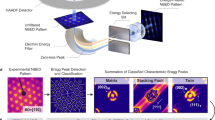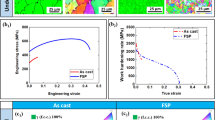Abstract
It has been known for decades that the application of pulsed direct current can significantly enhance the formability of metals. However, the detailed mechanisms of this effect have been difficult to separate from simple Joule heating. Here, we study the electroplastic deformation of Ti–Al (7 at.% Al), an alloy that is uniquely suited for uncoupling this behaviour because, contrary to most metals, it has inherently lower ductility at higher temperature. We find that during mechanical deformation, electropulsing enhances cross-slip, producing a wavy dislocation morphology, and enhances twinning, which is similar to what occurs during cryogenic deformation. As a consequence, dislocations are prevented from localizing into planar slip bands that would lead to the early failure of the alloy under tension. Our results demonstrate that this macroscopic electroplastic behaviour originates from defect-level microstructural reconfiguration that cannot be rationalized by simple Joule heating.
This is a preview of subscription content, access via your institution
Access options
Access Nature and 54 other Nature Portfolio journals
Get Nature+, our best-value online-access subscription
$29.99 / 30 days
cancel any time
Subscribe to this journal
Receive 12 print issues and online access
$259.00 per year
only $21.58 per issue
Buy this article
- Purchase on Springer Link
- Instant access to full article PDF
Prices may be subject to local taxes which are calculated during checkout




Similar content being viewed by others
Data availability
The data that support the findings of this study are available from the corresponding author upon reasonable request.
References
Conrad, H. Electroplasticity in metals and ceramics. Mater. Sci. Eng. A 287, 276–287 (2000).
Troitskii, O. A. Electromechanical effect in metals. JETP Lett. 10, 11 (1969).
Troitskii, O. A. Effect of the electron state of a metal on its mechanical properties and the phenomenon of electroplasticity. Strength Mater. 9, 35–45 (1977).
Okazaki, K., Kagawa, M. & Conrad, H. An evaluation of the contributions of skin, pinch and heating effects to the electroplastic effect in titatnium. Mater. Sci. Eng. 45, 109–116 (1980).
Conrad, H., Sprecher, A. F., Cao, W. D. & Lu, X. P. Electroplasticity—the effect of electricity on the mechanical properties of metals. JOM 42, 28–33 (1990).
Andre, D. et al. Investigation of the electroplastic effect using nanoindentation. Mater. Des. 183, 108153 (2019).
Xiang, S. & Zhang, X. Dislocation structure evolution under electroplastic effect. Mater. Sci. Eng. A 761, 138026 (2019).
Waryoba, D., Islam, Z., Wang, B. & Haque, A. Low temperature annealing of metals with electrical wind force effects. J. Mater. Sci. Technol. 35, 465–472 (2019).
Sheng, Y. et al. Application of high-density electropulsing to improve the performance of metallic materials: mechanisms, microstructure and properties. Materials 11, 185 (2018).
Li, W. et al. Non-octahedral-like dislocation glides in aluminum induced by athermal effect of electric pulse. J. Mater. Res. 31, 1193–1200 (2016).
Wang, X. et al. Current-induced ductility enhancement of a magnesium alloy AZ31 in uniaxial micro-tension below 373 K. Materials 12, 111 (2019).
Islam, Z., Wang, B. & Haque, A. Current density effects on the microstructure of zirconium thin films. Scr. Mater. 144, 18–21 (2018).
Zhao, Y. et al. Electropulsing strengthened 2GPa boron steel with good ductility. Mater. Des. 43, 195–199 (2013).
Sprecher, A. F., Mannan, S. L. & Conrad, H. Overview no. 49. Acta Metall. 34, 1145–1162 (1986).
Noell, P. J., Rodelas, J. M., Ghanbari, Z. N. & Laursen, C. M. Microstructural modification of additively manufactured metals by electropulsing. Addit. Manuf. 33, 101128 (2020).
Qin, R. S. & Bhowmik, A. Computational thermodynamics in electric current metallurgy. Mater. Sci. Technol. 31, 1560–1563 (2015).
Jiang, Y., Tang, G., Shek, C., Zhu, Y. & Xu, Z. On the thermodynamics and kinetics of electropulsing induced dissolution of β-Mg17Al12 phase in an aged Mg-9Al-1Zn. Acta Mater. 57, 4797–4808 (2009).
Savenko, V. V. Electroplastic deformation by twinning metals. Acta Mech. Autom. 12, 259–264 (2018).
Kravchenko, V. Y. Effect of directed electron beam on moving dislocations. Sov. Phys. JETP 24, 1135–1142 (1967).
Roshchupkin, A. M. & Bataronov, I. V. Physical basis of the electroplastic deformation of metals. Russ. Phys. J. 39, 230–236 (1996).
Klimov, K., Shnyrev, G. & Novikov, I. Electroplasticity in metals. J. Sov. Phys. Dokl. 19, 787–788 (1975).
Roshchupkin, A. M., Miloshenko, V. E. & Kalinin, V. E. The electron retardation of dislocations in metals. Fiz. Tverd. Tela 21, 909–910 (1979).
Molotskii, M. & Fleurov, V. Work hardening of crystals in a magnetic field. Philos. Mag. Lett. 73, 11–15 (1996).
Molotskii, M. I. Theoretical basis for electro- and magnetoplasticity. Mater. Sci. Eng. A 287, 248–258 (2000).
Lütjering, G. G. & Williams, J. C. Titanium (Springer, 2010).
Zhang, R. et al. Direct imaging of short-range order and its impact on deformation in Ti-6Al. Sci. Adv. 5, eaax2799 (2019).
Williams, J. C., Baggerly, R. G. & Paton, N. E. Deformation behavior of HCP Ti-Al alloy single crystals. Metall. Mater. Trans. A 33, 837–850 (2002).
Venkataraman, A. et al. Study of structure and deformation pathways in Ti-7Al using atomistic simulations, experiments, and characterization. Metall. Mater. Trans. A 48, 2222–2236 (2017).
Fitzner, A. et al. The effect of aluminium on twinning in binary alpha-titanium. Acta Mater. 103, 341–351 (2016).
Conrad, H. On the strengthening of titanium by aluminum. Scr. Metall. 7, 509–512 (1973).
Neeraj, T., Holc, D. H., Daehn, G. S. & Mills, M. J. Phenomenological and microstructural analysis of room temperature creep in titanium alloys. Acta Mater. 48, 1225–1238 (2000).
Neeraj, T. & Mills, M. J. Observation and analysis of weak-fringing faults in Ti-6 wt% Al. Philos. Mag. A 82, 779–802 (2002).
van de Walle, A. & Asta, M. First-principles investigation of perfect and diffuse antiphase boundaries in HCP-based Ti-Al alloys. Metall. Mater. Trans. A 33, 735–741 (2002).
Lubarda, V. A., Meyers, M. A. & Vo, O. The onset of twinning in metals: a constitutive description. Acta Mater. 49, 4025–4039 (2001).
Moskalenko, V. A., Startsev, V. I. & Kovaleva, V. N. Low temperature peculiarities of plastic deformation in titanium and its alloys. Cryogenics 20, 503–508 (1980).
Acknowledgements
We gratefully acknowledge funding from the US Office of Naval Research under grant no. N00014-17-1-2283. Work at the Molecular Foundry was supported by the Office of Science, Office of Basic Energy Sciences, of the US Department of Energy under contract no. DE-AC02-05CH11231.
Author information
Authors and Affiliations
Contributions
S.Z. and A.M.M. proposed the experiments. S.Z., R.Z. and Y.C. performed the mechanical testing with electrical pulsing. S.Z. and R.Z. conducted the TEM and high-resolution STEM characterization of the resultant dislocation structures and twins. S.Z. conducted the EBSD. E.R. and D.C.C. estimated the magnetostriction and thermal diffusivity effects. R.Z., A.A. and X.L. assisted with the literature review. A.A. and M.A. provided the electrical free energy discussion. S.Z., J.W.M. and A.M.M. drafted the manuscript and all the authors contributed to the discussions. J.W.M. and A.M.M. supervised the project.
Corresponding author
Ethics declarations
Competing interests
The authors declare no competing interests.
Additional information
Publisher’s note Springer Nature remains neutral with regard to jurisdictional claims in published maps and institutional affiliations.
Extended data
Extended Data Fig. 1 Dislocation morphology of Ti-7Al subjected to 2% of plastic strain using different loading conditions.
a, room temperature without pulsing shows planar dislocation configuration; (b) pulsing deformed showing wavy slip.
Extended Data Fig. 2 Planar dislocation configuration of materials subjected to continuous current.
a, Imaging condition near the basal plane and (b), imaging condition near the {11–23} plane. This Figure illustrates the dislocation structure deformed under continuous current (current density similar to the pulsing deformation reported in the main text). The temperature during deformation is measured to be around 200 °C. It is shown clearly, in two distinctive imaging conditions (A-near the basal plane, and B-near the {11–23} plane), that the dislocation exhibits a planar configuration, indicating a lack of cross-slip and is very similar to the deformation at room temperature. This suggests that raising temperature at this range cannot trigger planar-to-wavy transition.
Extended Data Fig. 3 Dislocation configuration from the as fractured tensile specimen.
a, high density of wavy dislocation tangles in pulsing deformed sample; (b) Planar dislocation bands in sample deformed at room temperature (RT).
Extended Data Fig. 4 Comparison of twinning ability in the different deformation conditions.
EBSD grain boundary misorientation analysis shows that both electrical pulsing and cryogenic deformation temperature lead to an enhanced twinning ability for the Ti-7Al alloy. The field of view of the EBSD scans is 200 µm × 500 µm along the gauge section of the tensile samples.
Extended Data Figure 5 Inverse pole figure mapping of pulsing vs. no-pulsing deformed sample.
It shows virtually no twins in the RT-deformed sample (a), whereas noticeable {10–12} twins are observed in the pulsing-deformed sample.
Extended Data Fig. 6 Secondary electron fractographic micrographs.
a, tensile sample after pulsing deformation and (b) tensile sample without pulsing treatment.
Extended Data Fig. 7 Schematic illustration of dislocation configurations.
a, At room temperature, dislocation prefer to slip on the prismatic plane and cut through the obstacles (Red, solute atoms or short-range order clusters). b, The subsequent dislocations tend to follow the leading dislocation due to slip-plane softening, leading to a planar dislocation configuration similar to what is shown in Fig. 2 (a, b). Note that the obstacles will be destroyed after the passage of several dislocations as each dislocation causes a shear displacement. c, Upon applying a pulsed current, dislocation prefer to cross-slip (shown here on the first order pyramidal plane). d, This mechanism helps dislocations bypass the obstacles, leading to a non-planar dislocation configuration, similar to what is shown in Fig. 2 (c, d).
Extended Data Fig. 8 Detailed illustration of the dog-bone tensile specimen.
a, Schematic drawings of the geometry of the sample mounted in our loading fixture; (b) the CAD model detailed dimension of the dog-bone sample.
Supplementary information
Supplementary Information
Supplementary text.
Supplementary Video 1
Infrared video of the specimen subjected to pulsed and continuous currents.
Rights and permissions
About this article
Cite this article
Zhao, S., Zhang, R., Chong, Y. et al. Defect reconfiguration in a Ti–Al alloy via electroplasticity. Nat. Mater. 20, 468–472 (2021). https://doi.org/10.1038/s41563-020-00817-z
Received:
Accepted:
Published:
Issue Date:
DOI: https://doi.org/10.1038/s41563-020-00817-z
This article is cited by
-
Quasi-instantaneous materials processing technology via high-intensity electrical nano pulsing
Scientific Reports (2024)
-
Effect of Strain Rate on the Mechanical Behavior of Al-Mg Alloy Under a Pulsed Electric Current
Metallurgical and Materials Transactions A (2024)
-
Microstructural Strengthening and Plastic Degradation of Ti–6Al–4V Induced by Laser Ablation
Metals and Materials International (2024)
-
Electroplasticity effects: from mechanism to application
The International Journal of Advanced Manufacturing Technology (2024)
-
Microstructure and mechanical properties of Co-28Cr-6Mo-0.22C investment castings by current solution treatment
China Foundry (2024)



